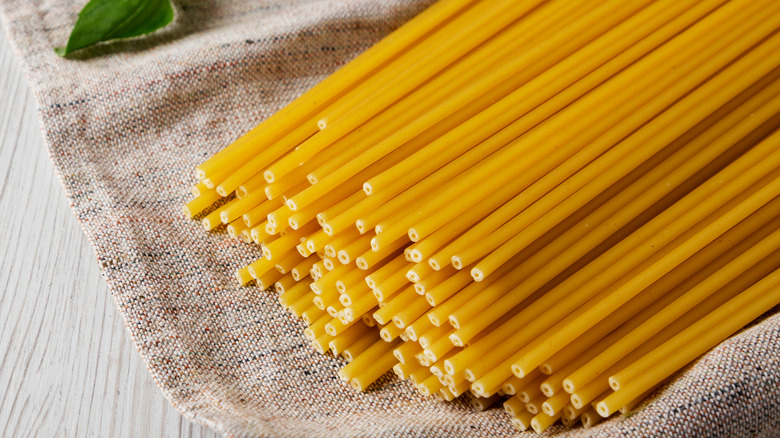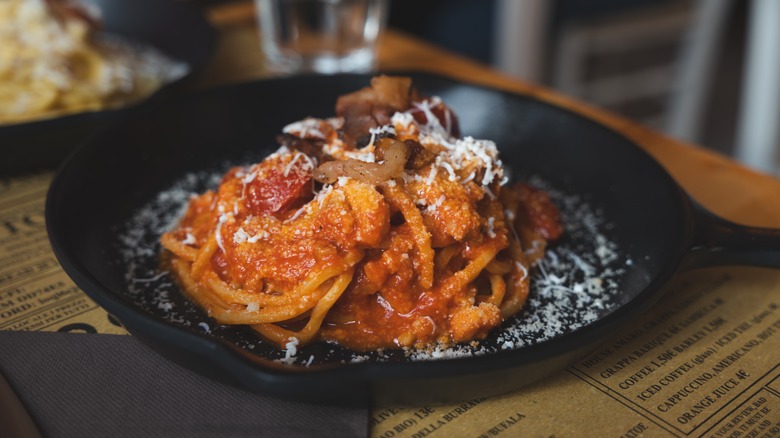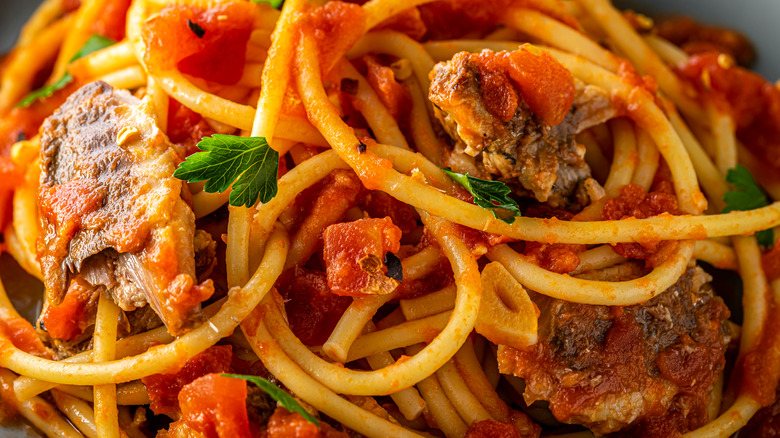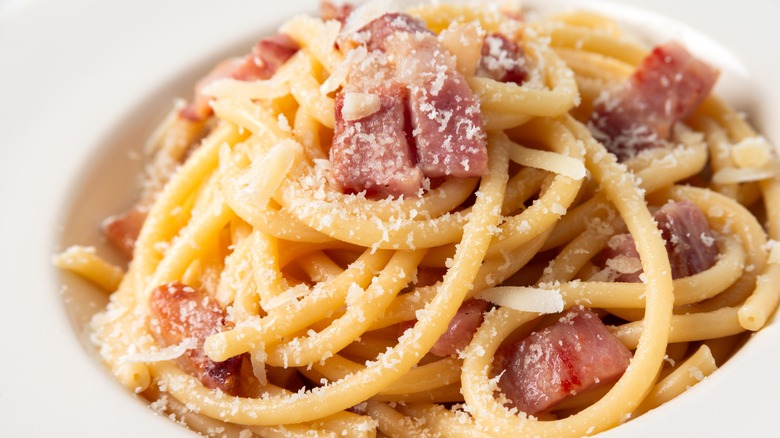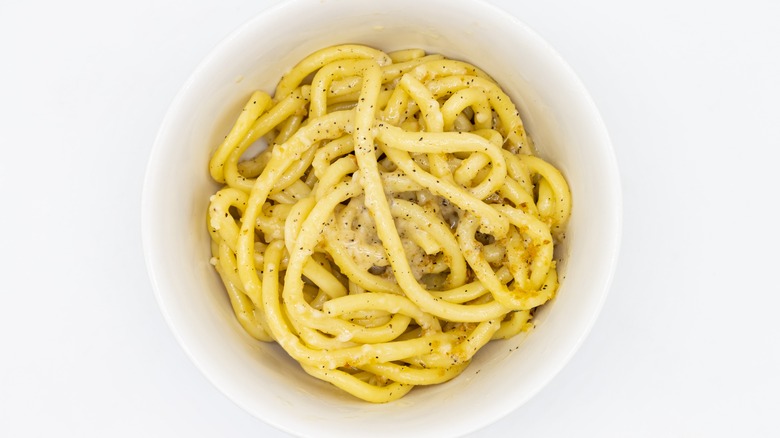The Best Sauce Pairings For Unbeatable Bucatini Pasta
If you've never sunk your teeth into an al dente strand of bucatini, boy are you missing out. While not one of the most obscure pasta shapes, it is certainly underrepresented, at least amongst American diners, for whom classics like spaghetti, penne, and rigatoni always seem to dominate store shelves and menus. For the uninitiated, bucatini is essentially a marriage between long pasta styles and tubed pasta styles. It looks like a really girthy strand of spaghetti, but there is a hole running up the center, almost like a narrow drinking straw. It's a bit sturdier than most long noodles, although the center hole ensures you don't get an undercooked center. The result is a delightfully toothsome bite, while the hollow core holds sauce fantastically well.
Every pasta aficionado should enjoy a bowl of bucatini at least once in their life, so consider picking up a box on your next grocery run. Of course, the question remains of what sauce to pair it with. For a rundown of the best bucatini dishes, Chowhound spoke to Chef Jasper J. Mirabile Jr. of Jasper's Italian Restaurant in Kansas City, Missouri. He's a man so passionate about pasta that he started a radio show called "Live! from Jasper's Kitchen" to spread the gospel of Italian cuisine. Chef Mirabile is a big fan of bucatini, and in his mind, there's one sauce pairing that stands above all the others: Amatriciana.
Amatriciana is the classic match for bucatini
Bucatini is most widely associated with traditional bucatini all'Amatriciana. Chef Mirabile calls this his favorite sauce, and a nostalgic one to boot. "As a child, it was always a treat when my father would make this on a Sunday," he recalls. Along with cacio e pepe, pasta alla gricia, and carbonara, Amatriciana is one of the core four pastas of Rome, although it is thought to be named after the town of Amatrice, about 90 miles to the east. Traditionally, it was served with spaghetti, but it has since become best associated with bucatini. As Chef Mirabile explains, "This cut of pasta helps hold the sauce better because of its unique shape."
Amatriciana, like the other three pastas of Rome, provides a lesson in the virtues of simplicity. The sauce starts by frying up some diced guanciale a type of cured pork jowl that is fairly similar to pancetta. The other key ingredients are tomatoes and red chile flakes. Some versions add onions, although this is not the traditional route. A showering of Rome's beloved Pecorino Romano cheese is essential to bring it all together. It's hearty and comforting, letting each ingredient shine. As good as it is though, it's far from the only option when it comes to bucatini.
Bucatini con le sarde is an underrated holiday classic
Although he calls Amatriciana his favorite sauce, Chef Mirabile also professes a deep passion for another, lesser-known bucatini pairing. "Being of Scicilian descent, I absolutely go crazy every March 19 for St. Joseph's Day, when our family uses this cut of pasta for the famous Sarde sugu." This dish, also known as pasta con le sarde, has a special link to the feast in question. St. Joseph's Day falls during the period of Lent, a time when eating meat is traditionally forbidden. In its place, fish are favored, and this particular dish gets its name from sardines.
There are a few different variations of pasta con le sarde, and Chef Mirabile specifically endorses, "Milanese pasta prepared with sardines, tomatoes, and fennel." Pasta Milanese is another common name for this traditional St. Joseph's Day meal, and it can also be made with a similar fish: anchovies. To finish off this dish, sprinkle it liberally with toasted breadcrumbs. These crumbs hold a special significance for the saint's day. They symbolize sawdust, a nod to Joseph's profession as a carpenter.
You can't go wrong with carbonara
A common theme you'll see with bucatini is its close association with Roman-style cuisine. That's because this particular pasta shape originated in Lazio, the Italian region where Rome (as well as the aforementioned Amatrice) is located. It is only fitting, then, that bucatini should be used for one of the most famous pasta dishes to ever emerge from Rome: carbonara. Although this dish is traditionally prepared with spaghetti, many restaurants in Rome do prepare it with bucatini. "When in Rome," Chef Mirabile notes, "I really enjoy when a restaurant serves bucatini pasta with authentic Roman carbonara."
What makes an "authentic" Roman carbonara? Chef Mirabile explains that it should only have three ingredients: "eggs, Romano cheese, and guanciale." As with Amatriciana, the first step is to fry the guanciale, rendering out some of the rich fat that is central to this sauce's beloved savory flavor. When you cook your bucatini, add it to the pan with the guanciale, and take the pan off the burner before adding the eggs, the residual heat of the pasta and guanciale will turn the eggs into a creamy, silky sauce — enriched by a healthy shower of pecorino romano, of course. A generous addition of freshly-cracked black pepper is also customary.
Cacio e pepe is the simplest sauce for bucatini
Bucatini might not be the top pasta on most people's radars, but its popularity has been skyrocketing as of late, particularly when it comes to one of the most popular pasta dishes in the world. "In the past few years," notes Chef Mirabile, "this cut of pasta has also become very popular with Cacio e Pepe, the simple sauce of Romano cheese and black pepper." That's right, it's yet another one of Rome's pasta pillars, and this one is the simplest of all. A classic Bucatini Cacio e Pepe would be a great starting point for cooks looking to explore this toothsome pasta shape.
Any of these sauces would be a great choice for bucatini, and you can explore beyond them as well. Keep in mind that the main strength of bucatini is its ability to hold sauces. Chef Mirabile ends with this basic principle: "I always reach for this kind of pasta when I have a hardy sauce and of course for St. Joseph's Day."
